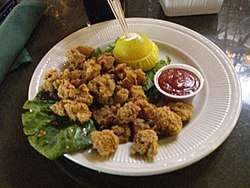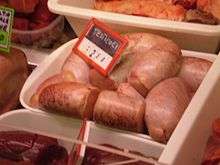Rocky Mountain oysters
 | |
| Alternative names | Prairie oysters, calf fries, cowboy oysters, |
|---|---|
| Course | Hors d'oeuvre |
| Place of origin | Canada and United States |
| Main ingredients | Testicles (bull calf), flour, pepper and, salt |

Rocky Mountain oysters, also known as prairie oysters in Canada, also calf fries, is a dish made of cattle testicles. The organs are often deep-fried after being peeled, coated in flour, pepper and salt, and sometimes pounded flat. This delicacy is most often served as an appetizer.[1]
North America
The novelty dish is served in parts of the American West and Western Canada where cattle ranching is prevalent and castration of young male animals is common. "Prairie oysters" is the preferred name in Canada where they are served in a demi-glace.[2] In Oklahoma and the Texas Panhandle, they are often called calf fries. In Spain, Argentina and many parts of Mexico they are referred to as "criadillas," and they are colloquially referred to as huevos de toro (literally, "bull’s eggs"; besides its literal meaning, huevos is a Spanish slang term for testicles) in Central and South America.[3] Rocky Mountain oysters are sometimes confused with lamb fries or animelles (lamb testicles), which are served in a similar manner. A few other terms, such as "cowboy caviar", "Montana tendergroins", "dusted nuts", "bull fries", "swinging beef", or simply “mountain oysters” may be used.[4]
The dish, purportedly cowboy fare,[5] is most commonly found served at festivals, amongst ranching families, or at certain specialty eating establishments and bars.[4] They are, however, also readily available at some public venues (e.g., at Coors Field during Colorado Rockies baseball games). Eagle, Idaho, claims to have the "World's Largest Rocky Mountain Oyster Feed" during its Eagle Fun Days (now held the second weekend in July).[6] Clinton, Montana, Deerfield, Michigan, Huntley, Illinois, Olean, Missouri, Severance, Colorado, and Tiro, Ohio also hold testicle festivals.[7] Rocky mountain oysters are sometimes served as a prank to those unaware of the origin of these "oysters". They are also considered to be an aphrodisiac by many people.[7]
The primary goal of testicle removal is not culinary. Castration in veterinary practice and animal husbandry is common and serves a variety of purposes, including the control of breeding, the growth of skeletal muscle suitable for beef, and temperament alteration.[8]
Similar dishes
Testicles from other animals can also be used in similar dishes. The most common is lamb fries made with testicles from castrated sheep. In some cases, pig testicles are used as well to make "pig fries".
Another dish found on occasion is turkey fries made from turkey testes. These are sometimes known as "short fries" as well.
See also
References
- ↑ Linda Stradley, http://www.deependdining.com/2004/09/rocky-mountain-oysters-old-mill-cedar.html
- ↑ metacafe.com. "Testicle Festival in Calgary Alberta". Metacafe.
- ↑ "Pensando En Los Huevos Del Toro - Eltiempo.Com". Archived from the original on 2012-07-31.
- 1 2 Stradley, Linda (20 May 2015). "Rocky Mountain Oysters Recipe and History".
- ↑ "Cowboy Grub, by Richard W. Slatta, proprietor of the Lazy S Ranch: Where cowboys roam the Old West".
- ↑ "Welcome to Eagle".
- 1 2 Runyon, Luke (October 20, 2016). "Rocky Mountain Oysters Are What?! We Try A Dish Of Cowboy Lore". The Salt. NPR. Retrieved September 2, 2017.
- ↑ "Castration: Not Cutting Will Cut Profits". www.cals.ncsu.edu.
External links
- Earles, Jim. "Rocky Mountain Oysters: Expanding on the List of Organ Meats," The Weston A. Price Foundation.
- Brown, Patricia Leigh. "Delicacy of the Wild West Lives on for Those So Bold," The New York Times, Wednesday, March 18, 2009.
- Lakey, Dwight, Songwriter. "Rocky Mountain Oysters," Songwriter Dwight Lakey's (ASCAP) song about Rocky Mountain oysters, © 2007 Brown Barn Publishing & Dwight Lakey, Danville, VT, & Julesburg, CO; All Rights Reserved.